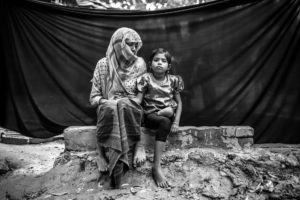Blog
The Rohingya: A Humanitarian Crisis
Written by Amrin Nahar
June 18, 2018
Many observers have described the flight of the Rohingya population from the Rakhine state in Myanmar as a rapid mass exodus. It’s estimated that more than 600,000 people have fled the violence, bringing the total number of Rohingya refugees in Bangladesh to around 900,000. On March 28th 2018 the Guardian published a photo series on the group in their ad hoc refugee camps in Bangladesh. The images brought home the terrible losses many of the refugees faced, and most importantly the things they were grateful for. The photo on the right was captioned:
‘‘The greatest loss we have suffered is her leg. And the most important gift that we have been given is her life — is the sound of her voice’
Queen Mary, University of London ‘s International State Crime Initiative recently published a report titled ‘Genocide Achieved, Genocide Continues: Myanmar’s Annihilation of the Rohingya.” The report sets out a comprehensive timeline beginning in the 1970s, which demonstrates the deeply entrenched hatred towards the Rohingya population. Policies such as the 1989 Citizens Act compounded the group’s systematic alienation, denying them recognition as full citizens of Myanmar. This indicates that the persecution of the Rohingya was not a ‘one-off’ event, but rather an enduring campaign.
MASS HUMAN RIGHTS VIOLATIONS
Over the past year the Myanmar military have been accused of sexual violence against Rohingya women and girls in their purported efforts to ‘free’ the Rakhine area of the group. However, the Burmese government and military authorities vehemently deny these accusations. Instead, they affirm their decision to respond to attacks carried out by Rohingya militants. The United Nations Security Council published a report on conflict related sexual-violence, which set out a clear definition :
The term “conflict-related sexual violence” refers to rape, sexual slavery, forced prostitution, forced pregnancy, forced abortion, enforced sterilization, forced marriage and any other form of sexual violence of comparable gravity perpetrated against women, men, girls or boys that is directly or indirectly linked to a conflict.
According to the report, while many Rohingya have managed to flee Myanmar, they face further misery in the refugee camps. This includes women who have become pregnant as a result of their treatment by the Myanmar military. Given the shame and stigma associated with rape in Rohingya culture, many will hide their pregnancies from their families. Human Rights Watch reported that over two thirds of the rape survivors who managed to flee have not reported their rape to authorities or aid organisations. The group’s ongoing displacement compounds such human rights violations.
There is considerable evidence of the Myanmar military’s involvement in the crisis and the government’s lack of response. How the crisis will unfold and when the Rohingya can find a place to call home again is unknown, as the international community has yet to respond conclusively to the group’s plight.
Image credit: Brian Sokol/UNHCR

